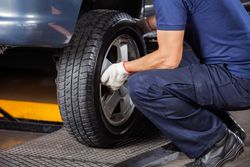
While those who drive more miles should plan them more frequently, tire rotations should generally be scheduled as routine vehicle maintenance every six months. Otherwise, uneven tread wear can occur, negatively affecting a vehicle’s performance. Here, find out what you need to know about this vital auto service.
What Happens During a Tire Rotation?
During a rotation, tires move from one wheel position on a vehicle to another. The type of vehicle you own — front-wheel drive, rear-wheel drive, or four-wheel drive — will determine the rotation pattern. Most cars are front-wheel drive vehicles, and their front tires are transferred to the rear wheels while the rear tires move to the front.
Tires also change sides. For example, the left and right front tires switch sides when moved to the vehicle's back. Your mechanic should follow the proper position pattern based on your vehicle’s owner’s manual.
Why Are Rotations Important?
 Tires that aren’t rotated experience uneven wear and tear of their tread. This can make handling your vehicle more difficult, especially in an emergency. For example, if you encountered a wet road and braked suddenly, uneven tread could cause you to hydroplane or slide across the asphalt.
Tires that aren’t rotated experience uneven wear and tear of their tread. This can make handling your vehicle more difficult, especially in an emergency. For example, if you encountered a wet road and braked suddenly, uneven tread could cause you to hydroplane or slide across the asphalt.
Drivers can also experience loud road noise and steering wheel vibrations, and in some cases, they can void their tire’s warranty by not having them rotated regularly. Tires with uneven tread also have short life spans and need to be replaced sooner than those inspected and serviced routinely.
Ohio’s drivers can keep their tires in top shape with routine inspections and service at Hudson Goodyear. This auto repair shop has specialized in tire rotations, alignments, and repairs for more than 30 years. Their team consists of skilled ASE®-certified technicians who can also help you choose a new set of quality tires if your vehicle needs replacements. Call (330) 650-8888 for a free estimate or visit them online today to learn more about their auto repair services.
About the Business
Have a question? Ask the experts!
Send your question

